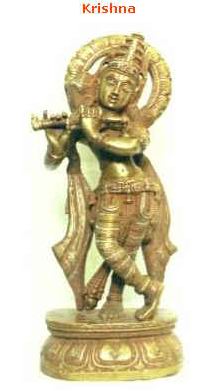
|
Krishna And Rama "If you recognise the distinction between Krishna and Rama, you will appreciate better the nature of Krishna. Krishna always smiled at the outset and carried out his task later. For Rama, the deed came first and then the smile. Krishna made women cry. Rama wept for the sake of women. Rama went into the battle only after having a strong cause for it. Krishna first provoked the conflict and determined its outcome. The Krishna principle revels in delight. The Rama principle is based on the concept of obligation. The Ramayana is intended to promote the reign of truth and righteousness on earth. The Krishna Avatar was intended to give a perennial message to the world. He sought nothing for himself. He gave away everything to the people. He slew his maternal uncle, Kansa. He installed on the throne Kansa's father Ugrasena. He did not covet the kingdom. He befriended the Pandavas, defeated the Kauravas and crowned Dharmaraja as emperor. He did not make himself king. He was a king without a crown. He was the King of kings. He had no kingdom of his own. But he rued over the hearts of the millions. It is this profound truth that is proclaimed by the Krishna principle (Krishna Tatwa). If you inquire deeply, you will find that every Avatar has incarnated to convey a special message and carry out a particular mission." Sai Baba, SS, 10/96, p. 256 Message Of The Gita "The message of the Bhagavad Gita has been interpreted by scholars in many different ways. They have argued that it prescribes the Karma Marga (the Path of Action), the Janana Marga (Path of Wisdom) and the Bhakti Marga (the Path of Devotion) as the primary path. But the real message of the Gita is to be got from the first word of the first Shioka (verse) 'Dharma' and the last word of the last Shioka 'Mama'. "Mama Dharma' - each individual has to act according to his duty - that is the lesson of the Gita. Householders should follow the 'Grihasta Dharma' (the duties of householders), old people should follow the 'Vaanaprastha' Dharma (the duties of those who have withdrawn from family duties). There are Sanyasa Dharma (the duties ofarenunciant) and Brahmachaari Dharma (the duties of a celibate during the years before marriage). These duties are prescribed for each in his particular stage in life and they should not be mixed up. The Gita taught these duties for people in different stages ('Ashramas')." Sai Baba, SS, 11/91, p. 299
Gita-Jayanti "The Bhagavad Gita contains the sacred lore of the spirit. Krishna gave unto mankind through Arjuna, the core of the Gita Message on the battlefield at 10.30 a.m. on the 'Kaartika Bahula Amaayasya' day. This was the day on which the great Mahabharata war commenced. Ten days later, when Bhishma fell in the battle, Sanjaya was informing Dhritarashtra of the proceedings on the battlefield. Dhritarashtra asked Sanjaya: ' Dharmakshetra Kurukshetra Samavetaah yuyutsavaha Mamakah Pandavashchaiva kimakuvata Sanjaya' Meaning: Gathered on the holy plain of Kurukshetra, 0 Sanjaya, what did my sons and sons of Pandu do?' This was on 'Margasira Suddha Ekadashi' day. Some consider this day as the 'Gita Jayanti' or the day on which Krishna vouchsafed the message of the Gita to Arjuna. But this was the day on which Sanjaya narrated the story of the battle to Dhritarashtra. Gita was actually was given by Krishna to Arjuna on the 'Kaartika Bahula Amaavasya' day. Why did Krishna choose the Amaavasya day for the commencement of the battle and so for the teaching of the Gita? Normally, nothing auspicious is done on an Amaavasya day. However, such examples of Krishna's divinely enigmatic ways are there in other episodes of his life too. His birth on an Ashtami day is a case in point." Sai Baba, Summer Showers in Brindavan- 1979, pp. 158&159 Bhagavatam In His first discourse of the Summer Course, held in Brindavan from May 20th to May 30th, 1995, Bhaeavan pointed "the four qualifications needed by anyone to understand the underlying significance of the Bhagavatam, which describes devotion as a bridge between the Divine and the devotees. They are: (1) Flee from evil company (2) Seek company of the pious (3) Indulge always in meritorious deeds (4) Discriminate between the eternal and the transient. " Sai Baba, SS. 7/95, p. 175 & 176 "In the Bhagavatam, the lessons you leam are according to the state of your mind. To understand the glories of the Lord, you have to enjoy the 'Leelas' of Krishna and realise their inner meaning." Sai Baba, SS, 10/96, 257 Gita Govidam "Gita Govindam, the Book of Songs ofGovinda (Krishna) by the great mystic and poet, Jayadeva of Orissa, is immortal portrayal of Radha Bhakti in its manifold manifestations. Jayadeva could express it with such charm and clarity that even the man behind the plough sang those songs and filled hisJheart with divine delight. The ruler of the land, Lakshamana Sena, was stricken with envy. He prepared a parallel book of songs and ordered that they be sung, instead of Jayadeva's outpourings, in the temples of the land, including the greatest of them all - the Jagannath Temple at Puri. When his order was received with protest, the king had both books placed at the Feet of Lord Jagannath and the shrine was locked and kept under strict vigilance. When the doors were opened in the morning, the king saw the Lord having Jayadeva's 'Gita Govindam' in His Hand, while his rival book written out of envy and pride was thrown into a far comer. The Lord has announced that he showers Grace on inner purity, not outer pomp." Sai Baba, 9/85, p. 232 |
